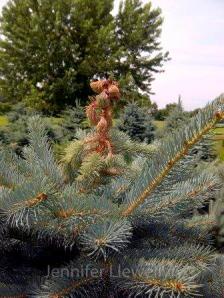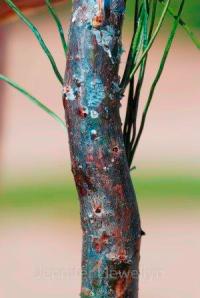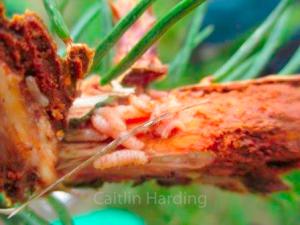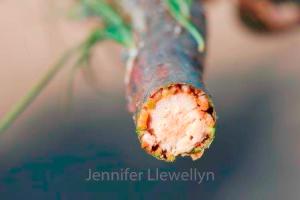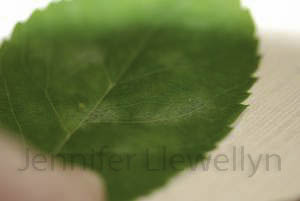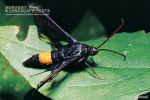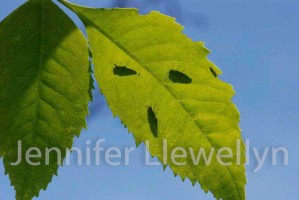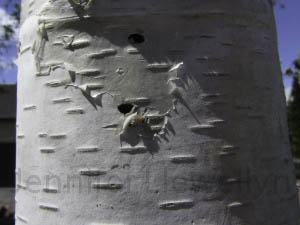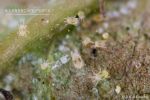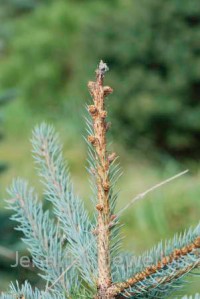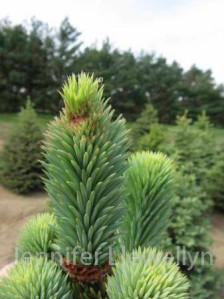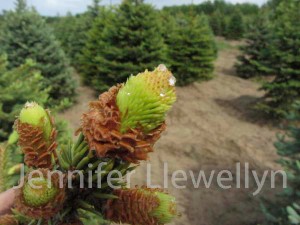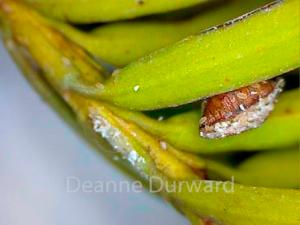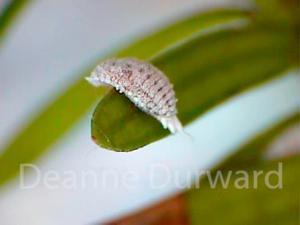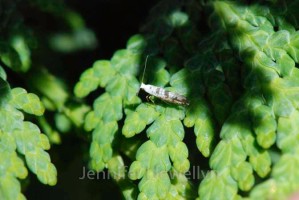You have reached Jen Llewellyn for the 11th edition of the 2013 OMAF and MRA Nursery and Landscape Report, updated on Friday, June 28th.
Environment Canada is calling for cloudy, rainy conditions with much cooler temperatures for this Canada Day long weekend. Daytime highs are expected to be in the range of 20-24oC in many areas. Great weather for planting nursery stock !!!
Japanese beetle adults should be flying and starting to feed on leaves of woody plants (Syringa, Tilia, Ulmus, Prunus, Rosa). Look for metallic, coppery-green beetles with white turfts of hairs along the edge of their abdomens.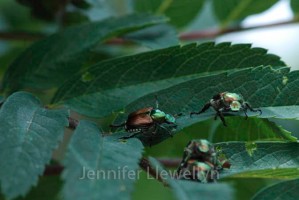 Adulticide insecticides for JB in the nursery include Sevin XLR and Thionex. Pheromone traps for JB are extremely good at attracting the adults. Always place traps AWAY from susceptible host trees and shrubs.
Adulticide insecticides for JB in the nursery include Sevin XLR and Thionex. Pheromone traps for JB are extremely good at attracting the adults. Always place traps AWAY from susceptible host trees and shrubs.
Are you seeing flagging leaders on spruce and pine in the landscape and nursery? Check shoots for weeping sap as a sign of insects boring inside. If you snip off the “dying” terminal, slice into the shoot and look for chewed bark and little white, legless larvae. These are likely White Pine Weevil larvae.
Plant Phenology indicators this week.
A) North of 401 (300-400 GDD Base 10oC): Catalpa speciosa (early bloom), Syringa reticulata (full to late bloom), Spiraea nipponica (late bloom), Weigela florida (full bloom)
B) Niagara: Catalpa speciosa (full bloom), Daucus carota (early bloom), Syringa reticulata (full to late bloom),Weigela florida (late bloom), Yucca filamentosa (early bloom)
C) London area: if you would like to report plant phenology events, please contact me.
D) Leamington-Windsor: if you would like to report plant phenology events, please contact me.
If you are referring to the Monitoring tables in the 2009 edition of publication 383, Nursery and Landscape Plant Production and IPM, look at Tables starting on pg. 64.
PLEASE NOTE: The Following Pesticide Recommendations are meant for Exception Uses (e.g. agriculture) under the Cosmetic Pesticide Ban unless the active ingredient is listed under Class 11 pesticides in Ontario Regulation 63/09, effective April 22, 2009.
 The 2013 Crop Protection Guide for Nursery and Landscape Plants (previously 383, now publication 840) can now be found at: http://www.omafra.gov.on.ca/english/crops/pub840/p840order.htm It contains the crop pest recommendations for nursery and landscape plants that was previously found in publication 383. Publication 840 is a .pdf file, accessible online and on cd.
The 2013 Crop Protection Guide for Nursery and Landscape Plants (previously 383, now publication 840) can now be found at: http://www.omafra.gov.on.ca/english/crops/pub840/p840order.htm It contains the crop pest recommendations for nursery and landscape plants that was previously found in publication 383. Publication 840 is a .pdf file, accessible online and on cd.
 Nursery-Landscape Insect Pest ID: Dave Cheung’s Common Pests of Nursery-Landscape database to help ID your problem pests. Check out www.dkbdigitaldesigns.com/clm
Nursery-Landscape Insect Pest ID: Dave Cheung’s Common Pests of Nursery-Landscape database to help ID your problem pests. Check out www.dkbdigitaldesigns.com/clm
EDUCATIONAL EVENTS:
Arboriculture and Landscape. Tuesday, July 9 at the University of Guelph Arboretum Centre. ISA Ontario Workshop: “IPM in the Woody Landscape”. Come spend the day learning about current pests and physiological problems on trees and shrubs. This workshop will be led by Jen Llewellyn with Dr. Shannon Shan and Sean Fox. CEU’s are available! To register, click here.
Grower. Wednesday, July 10 at the Copetown Community Centre. IPPS Ontario Region Plant Propagator’s Seminar and Nursery Tour. Come to beautiful Copetown to learn about the latest research in container production and spend the afternoon viewing real-life application of this research to commercial nursery production. To register click here.
Grower. Thursday, August 15 at J.C. Bakker & Sons Nurseries. “Intelligent Sprayer Demo Day”. If a new sprayer design could reduce crop protection inputs by 70 per cent, would you be interested? Come and see for yourself, the “intelligent sprayer”, designed and customized for nursery production systems, will be demonstrated for its efficiency and efficacy on real-life commercial nursery crops. Dr. Heping Zhu, well known for his extension work at Ohio State University and associate Randy Zondag will be sharing their latest research with us in St. Catharines. Rain day: August 16. To register, click here.
VARIOUS ORNAMENTALS:
Have white grubs been an issue in your nursery? Preventative applications of Intercept (imidacloprid) are registered for white grubs (nursery production) and the application period is in June and July (during the adult flight period for the adult stage). To help qualify for the Japanese beetle certification program, an application of Intercept 60WP on container stock or field stock should made between mid-June to July (adults flight period). The cut-off period for Intercept applications to comply with the JB Certification program this year may be as early as July 31st. Beneficial nematode applications for white grubs (e.g. European chafer) are not effective at this time. Try timing nematode applications for mid-late August to catch early instar larvae in the landscape/turf.
Japanese beetle adults should be flying and starting to feed on leaves of woody plants (Syringa, Tilia, Ulmus, Prunus, Rosa). Look for metallic, coppery-green beetles with white turfts of hairs along the edge of their abdomens. Adulticide insecticides for JB in the nursery include Sevin XLR and Thionex. Pheromone traps for JB are extremely good at attracting the adults. Always place traps AWAY from susceptible host trees and shrubs.
Adulticide insecticides for JB in the nursery include Sevin XLR and Thionex. Pheromone traps for JB are extremely good at attracting the adults. Always place traps AWAY from susceptible host trees and shrubs.
DECIDUOUS WOODY AND HERBACEOUS PERENNIALS:
We have seen more powdery mildew on deciduous flowering shrubs (Amelanchier, Rosa) and herbaceous perennials. Monitor for white, powdery residue on the tops and bottoms of leaves. Protect new foliage with fungicide applications (e.g. Switch, Milstop, Regalia (bio)) where the history of disease pressure is moderate to high.
Peach tree borer (Synanthedon exitosa) adults are flying for the next few weeks. Look for cankered regions and chewed bark/wood in the lower stems of Prunus (Prunus x cistena) as a sign of larval damage. These clear-wing moths resemble wasps.
Adult Peach tree borer moths are very much attracted to sticky wing traps that are baited with peach tree borer pheromones. Place pheromone traps out in early-mid June (approximately 390 GDD Base 10oC, ‘Red Prince’ Weigela in full bloom) and monitor for peak flight of adults. You can expect peak egg hatch around 10-14 days later, if you are thinking of treating newly-hatched larvae. The same ‘clearwing moth’ pheromones and traps can be used to monitor for Viburnum borer. Viburnum borer chews the stem (at and below the soil line) and causes significant injury to container grown Viburnum. Viburnum borer will be starting to emerge in container production at this time. To purchase traps, try ordering from IPM suppliers such as www.greatlakesipm.com and www.naturalinsectcontrol.com. Some growers are trying soil drench applications of beneficial nematodes, S.c., (Steinernema carpocapsae) after peak adult flight, as a biological way to suppress hatching larvae. We found that bark applications of S.c. gave a significant reduction in # larvae in a field trial last year.
Emerald ash borer adults are flying and feeding on ash leaves at this time.
Injectable insecticides may be used to protect ash trees from new infestations of Emerald Ash Borer (Agrilus planipennis). Trees must be actively transpiring in order to maximize insecticide uptake into the cambium. Registered injectable insecticide products include: AceCap 97, Confidor 200 SL and Tree-Azin. Check out the Management Strategy for Emerald Ash Borer and Bronze Birch Borer at: http://www.omafra.gov.on.ca/english/crops/insects/eab-bbb-manage.htm. Emerald ash borer adults start to emerge when the black locust (Robinia pseudoacacia) are blooming.
The regulated areas for Emerald Ash Borer in Ontario and Quebec can be found at:
The regulated areas for EAB outlines restrictions on the movement of all ash species (Fraxinus sp.) materials and all species of firewood from these regulated areas of Ontario and Quebec.
Adult bronze birch borer beetles are actively laying eggs on the bark of susceptible birch (e.g. Betula pendula). Symptoms of larval boring damage appear as branch tip death, branch death and death of the leader and progresses quite quickly. Destroy pruned material to prevent emergence of beetles. Natural resistance to this pest can be enhanced through activities that improve plant health, such as light fertilizing (May, October), irrigating and removing any weeds and grasses that provide competition for the tree. Betula pendula is most susceptible to this pest and should be avoided in areas of known BBB infestation. Betula nigra and its selections have been shown to be quite tolerant to BBB attack. Confidor injectable insecticide is labelled for bronze birch borer.
 Honeylocust plant bug NYMPHS and ADULTS are plaguing Honeylocust trees big time this year. The tiny, green plant bugs will actually rain down on you if you stand underneathe them or give the branch a little shake. Treat nymphs with Insecticidal Soap to reduce populations. Adults are very mobile and much more difficult to contact with insecticides. Overlapping life stages exist at this point, management with insecticides is difficult.
Honeylocust plant bug NYMPHS and ADULTS are plaguing Honeylocust trees big time this year. The tiny, green plant bugs will actually rain down on you if you stand underneathe them or give the branch a little shake. Treat nymphs with Insecticidal Soap to reduce populations. Adults are very mobile and much more difficult to contact with insecticides. Overlapping life stages exist at this point, management with insecticides is difficult.
Potato leafhoppers NYMPHS and ADULTS are feeding on woody nursery stock. Monitor for potato leafhopper on nursery crops such as Caragana, and Acer (platanoides, saccharum). Nymphs are about 2 mm long and scuttle SIDEWAYS, rather quickly, across the leaf and to the other side (they don’t have wings to fly away). Susceptible crops are those that are flushing new leaves (leafhopper’s favourite food source). Older, hardened off foliage is not usually as susceptible. Leafhopper adults are winged, are very mobile, tiny, pale yellow-green jumping insects that are easily disturbed when you approach infested foliage. It almost looks as though they are being flicked off of the foliage. Leafhoppers (and aphids) suck plant sap from soft, expanding foliage and cause foliage to wilt, turn brown/black (‘Hopper Burn”) and become stunted and malformed. Older, hardened off foliage will become flecked from leafhopper feeding. Monitor populations and treat the 1st generation NYMPHS with insecticides before damage becomes economically threatening. Leafhoppers are also attracted to yellow sticky cards, for monitoring. Registered insecticides include Tristar and Sevin XLR.
Aphids are quite numerous on herbaceous and woody ornamentals this year! They do well in cool weather because leaves stay soft and easy to feed on. Green peach aphid is one of the most common species and melon aphid and foxglove aphid are also quite common. This year we are seeing large colonies of black bean aphid (Aphis fabae) on deciduous flowering shrubs and Euonymus. Aphids are sucking insects that cause stunting, malformation and coat plants in honeydew. They also attract ants. Various insecticides are registered to manage aphids in outdoor production nurseries including Endeavor, Tristar and Trounce. In greenhouses insecticides include Endeavor, Intercept and Enstar EW. Where populations aren’t immediately economically damaging, biological control (e.g. Aphidius, Aphidoletes) may provide excellent management when introduced on a regular basis. Biocontrol suppliers include Biobest, Koppert, Plant Products and Canadian Hydrogardens.
Gypsy moth larvae (3rd and later instars) are moving into their heaviest feeding period in the next couple of weeks.
Larvae can be found on many deciduous trees (e.g. Ulmus, Acer, Quercus, Betula etc.) and evergreens (Colorado spruce!). Most larvae have black hairs but sometimes they have reddish-brown hairs that can cause their mis-identification. Some larval management can be achieved using spinosad (Success) (B.t. doesn’t work as well once the head capsule turns yellow). Some keen homeowners can install a burlap skirt at the base of the tree to create a shady, protected area for larvae to hide during the day (this behaviour usually peaks near the end of May). Homeowners will need to inspect burlap skirts and underlying bark crevices daily (1-3 pm is best) and remove/destroy napping larvae. Sticky bands around trunks during the June/July flight period will help prevent females from laying eggs above sticky bands and will attract males to the sticky surface.
Two-spotted spider mites (TSSM) has shown up on Viburnum and Spiraea in container production in the past and has been reported on dogwood. Use your hand lens to see tiny, clear bodied mites with dark regions (may be faint black) on their backs.
These mites are small but the damage is significant so catch them early. Miticides registered for this mite in the greenhouse include: DynoMite, Vendex, Kanemite, Floramite, Avid. Apollo is registered in outdoor nursery crops to knock down the egg stage and newly hatched nymphs. In the greenhouse, biocontrol agents should be brought in to coincide with the first sign of TSSM. Phytoseiulus persimilis is a predatory mite that feeds on TSSM when temperatures are below 26oC and it is a good choice when TSSM populations are low-moderate. Amblyseius californicus is a predatory mite that can be brought in ahead of TSSM appearance (because it can find other sources of food).
Maple spider mite (Olygonychus aceri) can be found feeding on the undersides of leaves of red and red x silver maple hybrids. 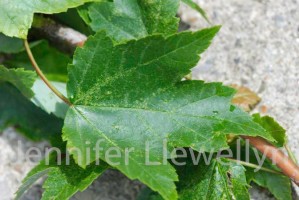
The mites look just like their cousins, spruce spider mites. We saw some mild damage in nursery grown trees this week. When populations are high, damage can cause significant leaf chlorosis and stippling and sometimes, premature leaf drop. Try miticides (Floramite, Kanemite, Vendex, insecticidal soap) where populations are high.
EVERGREENS:
Are you seeing dieback on last years leaders/terminal on Colorado spruce?
We have been seeing leader dieback on Colorado spruce for the last 5 years in field production and sometimes, on landscape specimens. The leader seems to die over the winter and the buds will either fail to emerge in spring (image on left) or will emerge and will fail before they reach full needle expansion (image on right). We have dissected SEVERAL dead leaders and have found no sign of insect damage or disease. It may be a physiological response to stress and perhaps exacerbated by nutrient deficiency. (If it was white pine weevil, you would see tiny white, legless larvae inside this year’s shoot.)
Where new foliage is emerging on conifers, monitor for needlecast and blight diseases in the area. Diplodia tip blight on 2 and 3 needled pines and Rhizosphaera needlecast and Stigmina on blue Colorado spruce are our most common needlecast diseases in Ontario. Diplodia tip blight appears as brown, stunted needles at the tips of branches. Rhizosphaera appears as brown-purplish needles from the previous year’s growth, symptomatic needles begin to drop in late spring. Stigmina appears on green and chlorotic needles, but doesn’t always lead to needle drop. To confirm it is Rhizosphaera, look at the undersides of the needles. Those little white dots (stomata) will turn black and the black spots will protrude during sporulation. New, soft growth is especially susceptible to foliar diseases, but infection may also take place later in the season (we don’t know). Where there is a history of damage, treat with registered fungicides (copper oxychloride, Banner Maxx, Daconil) as buds start to open and protect new foliage. Apply fungicides prior to precipitation events (spore dispersal). Unfortunately, most of these blights and needlecasts can be found sporulating for much of the year.
The first generation of Euonymus scale crawlers are hatching in container production and will be in the field and landscape very soon. Euonymus scale look like tiny white flecks (males) and tiny brown sea shells (females) along twigs and the undersides of leaves. Look for bright, orange crawlers 
around populations of adults and on the undersides of leaves and twigs. Where insecticide applications are warranted, multiple applications may be required to get good knockdown since crawler emergence is staggered over a few weeks. Try insecticidal soap and the summer rate of horticultural oil.
Are you seeing chewing damage on emerging new shoots of Colorado spruce in field production? Some nursery growers indicate that the raucus weevil has been defoliating new terminals on nursery-grown spruce. Where populations are damaging, try insecticidal applications during early morning to target adults (Pounce).
Look for crooked, wilting and browning terminal shoots on pine and spruce, it could be boring larvae from white pine weevil. Where appropriate, slice into bark and look for tiny, fat, white, legless grubs feeding in the cambium. Insecticide control is too late at this point, prune out and destroy all symptomatic terminals and train a new leader.
Look for tiny larvae of 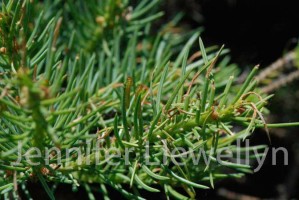 Yellow-headed spruce sawfly feeding on tender new needles of spruce (e.g. Colorado spruce) in the landscape. Larvae are green with lighter longitudinal stripes, yellow-brown heads. There are several insecticides registered including Dragnet, Dylox, Pounce and Success to target young larvae. This is a damaging pest of spruce in York region and has caused significant damage to spruce trees.
Yellow-headed spruce sawfly feeding on tender new needles of spruce (e.g. Colorado spruce) in the landscape. Larvae are green with lighter longitudinal stripes, yellow-brown heads. There are several insecticides registered including Dragnet, Dylox, Pounce and Success to target young larvae. This is a damaging pest of spruce in York region and has caused significant damage to spruce trees.
Larvae of European pine sawfly are feeding in clusters on last year’s (and older) needles and our nursery scout is finding them in many places. Larvae are greenish-yellow with dark head. They rear their bodies up in unison when alarmed. They can often be found on the top half of the tree, on the NE side. There are several insecticides registered for this pest. A low toxic pesticide choice is Success or Dragnet. Closely examine twigs of Pinus sylvestris, Pinus mugo, Pinus nigra.
Pine false webworm larvae will be found on white pine When eggs hatch, larvae snip off foliage and make webby nests near the trunk. The larvae clip off more needles and pull them into the webby nest where they feed on them. The larvae feed mainly on older growth and will only eat the current year’s growth when all else has been consumed. The new nests can be dislodged with a strong stream of water.
Taxus or Fletcher Scale eggs are hatching underneath brown, dead mother scales on foliage and twigs of Taxus and Thuja. Pick tiny, dark, bulbous adult female scale off to reveal white eggs underneath (about the size of grains of salt). These eggs are hatching over the next few weeks ( look for “eggs with legs“). Crawlers are really tiny, clear-white and REALLY difficult to see.
Crawlers will hide under females shells and will hatch over a period of 2-3 weeks. Therefore, two-three applications of insecticide will be needed to reduce crawler populations and reduce further injury. Insecticidal soap and several contact insecticides are registered for Fletcher scale crawlers.
Taxus mealybug nymphs will be showing up. Adult mealybugs are bright white (3-5 mm), waxy looking flat insects that barely move. They can be found on twigs of older Taxus in field production in hedges.
They produce honeydew therefore, black sooty mould is apparent on infested plants. Where populations are high, nymphs are sensitive to applications of insecticidal soap, horticultural oil, Trounce, Sevin and many others.
Cedar leaf miner (CLM) moths may still be active, there are several moth species that are leafminers of Thuja.
Tear along the margin of green and brown tissue and check for the presence of hollowed out tissue to confirm it is leafminer damage. We have seen quite a bit of CLM in field grown Thuja on sandy soils this spring. Adulticides (malathion) are registered for the moth life stage in nursery production.
Cooley spruce gall adelgid and Eastern spruce gall adelgid will be forming galls on new twigs of spruce at this time. Galls do not usually have much effect on plant growth but appear unsightly in summer when they turn brown. Where populations are high, the adelgids are susceptible to chemical control (or horticultural oil applications when dormant) when buds start to swell. Target pesticide applications to the undersides of shoot tips. Use wettable powder formulations on blue spruce to prevent foliar discolouration. Heavy populations of spruce gall adelgid are often a sign of some other underlying cause of stress or root problem in the tree.
Monitor for nymphs and adults of spruce spider mite on conifers with a history of mite damage. Spruce spider mite nymphs and adults are brown with black backs and found on new foliage this time of year. Miticides registered for SSM include Floramite and Kanemite. Miticides may be required where pest pressure is moderate to heavy.
THIS MESSAGE WILL BE UPDATED the week of July 5.

